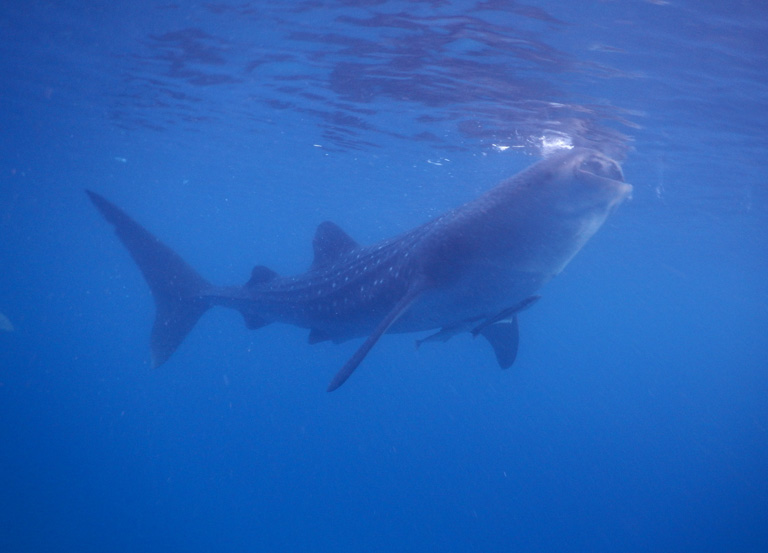- Scientists followed the movements of a whale shark for nearly two and a half years as she swam more than 20,000 kilometers (over 12,000 miles) from the coast of Central America to the Marianas Trench near Asia.
- Whale sharks, whose numbers have dropped by more than half in the past 75 years according to the IUCN, are taken by fishing boats for their fins, cartilage, meat and teeth, and studies have shown that boats bringing tourists to swim with the largest fish in the ocean change the species’ behavior.
- Given these threats, scientists hope studies such as this one will help guide conservation policy aimed at protecting these animals throughout their migrations.
A team of scientists has tracked a whale shark (Rhincodon typus) across more than 20,000 kilometers (over 12,000 miles) of ocean, the longest migration ever recorded for the species.

In 2011, the researchers attached a transmitting tag to a shark they named “Anne” in the Pacific Ocean near Panama’s Coiba Island. Over the next 841 days, Anne’s transmitter would ping the ARGOS satellite whenever she swam near the surface. Those data points allowed the team to follow her movements south to the Galapagos Islands and clear across the Pacific to the Marianas Trench south of Japan and east of the Philippines — a distance of 20,142 kilometers (12,516 miles).
They reported their findings in the journal Marine Biodiversity Records in April.
The discovery solidifies the whale shark’s place among the ocean’s most widely traveled creatures, alongside leatherback sea turtles, gray whales and Arctic terns. Another whale shark tagged in 1995 held the previous record for the species with a 13,000-kilometer (8,100-mile) swim in 37 months.
But beyond knowing that they’re capable of swimming vast distances — females can cover 67 kilometers (42 miles) in a single day — there’s still a lot to learn about whale sharks.
“When I first began working on them, their taxonomy was debated, and it still wasn’t clear how they reproduced,” study co-author and biologist Scott Eckert of Principia College in Illinois said in a statement. “Despite being the world’s largest fish, it’s amazing to me how little we know about this species.”

Part of the reason for those gaps in our knowledge is that whale sharks’ movements are difficult to track. In the course of this research, the scientists had to contend with a 235-day period during which they received no transmissions from Anne’s tag. She had likely dived too deep — whale sharks can plunge to depths of almost 2 kilometers, or more than a mile — for the tag to communicate with the satellite.
The team hopes that plotting out the course Anne and other whale sharks take will help to understand what motivates them.
“We have very little information about why whale sharks migrate,” Héctor M. Guzmán, a marine biologist at the Smithsonian Tropical Research Institute and the study’s lead author, said in the statement. “Are they searching for food, seeking breeding opportunities or driven by some other impulse?”
Evidence has surfaced in previous studies showing that even whale sharks living thousands of kilometers away from each other are still pretty closely related, so reproduction probably has something to do with these long-distance treks.

A more nuanced understanding of their behavior could also help scientists, conservationists and policymakers try to navigate the challenge of protecting such a cosmopolitan animal, especially with all of the threats that whale sharks face. They can ingest plastic as they siphon plankton from the water column, and fishing boats target them for their fins, cartilage and meat.
Even the tourist boats that bring swimmers and divers who want to share the current with a fish that grows as long as 12 meters (40 feet) and weighs up to 19,000 kilograms (21 tons) could be posing problems. Guzmán said researchers have found that the whale sharks around Coiba Island try to stay away from people.
In 2016, the IUCN listed the species as endangered for the first time. And biologists figure that the world’s tropical and subtropical seas hold fewer than half the number of whale sharks that they did 75 years ago, increasing the urgency for their protection.
“These studies are critical as we design international policy to protect transboundary species like the whale sharks and other highly migratory marine species,” Guzmán said.
Banner image of a whale shark at the Georgia Aquarium by Zac Wolf via Wikimedia Commons (CC BY-SA 2.5).
Citation
Guzman, H. M., Gomez, C. G., Hearn, A., & Eckert, S. A. (2018). Longest recorded trans-Pacific migration of a whale shark (Rhincodon typus). Marine Biodiversity Records, 11(1), 8.
FEEDBACK: Use this form to send a message to the author of this post. If you want to post a public comment, you can do that at the bottom of the page.
